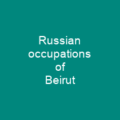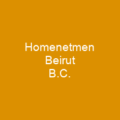Beirut: A City of Endless Layers and Rich History
Imagine a city that has been inhabited for over 5,000 years, where every stone whispers tales of ancient civilizations and modern struggles. That’s Beirut, the capital and largest city of Lebanon. With a population of over 2.5 million people, it is one of the oldest cities in the world, a melting pot of cultures, and a vibrant hub of commerce and culture.
The Ancient Roots
Beirut’s name comes from Phoenician “bēʾrūt,” meaning “wells,” due to its accessible water table. The city has been through countless transformations, each layer adding to its rich tapestry. From the Phoenicians who built a thriving port, to the Romans who expanded it into a major trading center, Beirut’s history is a story of resilience and adaptation.
Archaeological Layers
Excavations have unearthed layers of human habitation dating back to the Neolithic period. Fragments of history lie beneath the bustling streets of today’s Beirut, waiting to be discovered by curious archaeologists.
The Roman Era and Beyond
During the Roman era, Beirut became a center for learning with the establishment of a law school. The city was conquered by various empires over the centuries—Phoenicians, Romans, Byzantines, Crusaders, Mamluks, Ottomans, and more. Each left its mark on this resilient city.
Modern Challenges
The Lebanese Civil War (1975-1990) was a devastating chapter in Beirut’s history. The city was torn apart by conflict, with much of it being destroyed or damaged. However, the resilience of its people is evident as they continue to rebuild and restore their beloved city.
Modern-Day Beirut
Today, Beirut is a bustling metropolis that has managed to retain its charm amidst rapid development. The Beirut Central District (BCD) is a testament to this balance, with its mix of historical architecture and modern business environments. The district’s total area is 4,690,000 square meters, mostly dedicated to residential space, with over 60 gardens, squares, and open spaces.
Service-Oriented Economy
The city’s economy is service-oriented, with main growth sectors being banking and tourism. Beirut has been ranked as one of the best cities in the world by various publications, including Travel + Leisure, The Guardian, and The New York Times. It was chosen as the best city in the Middle East by Condé Nast Traveller in 2012.
Cultural Hotspots
Beirut is a cultural hub with numerous museums, art galleries, and cultural hotspots such as Rue Monnot, Rue Gouraud, and “The Alleyway” in Hamra Street. The city also features various cultural events including the Francophonie summit, Arab League summit, Jeux de la Francophonie, Prix Albert Londres ceremony, and World Book Capital award.
Conclusion
Beirut is a city that has seen it all—ancient civilizations, empires, wars, and now, the challenges of modern times. Yet, despite everything, it continues to thrive, drawing in visitors from around the world with its rich history, vibrant culture, and resilient spirit.
You want to know more about Beirut?
This page is based on the article Beirut published in Wikipedia (retrieved on November 24, 2024) and was automatically summarized using artificial intelligence.








